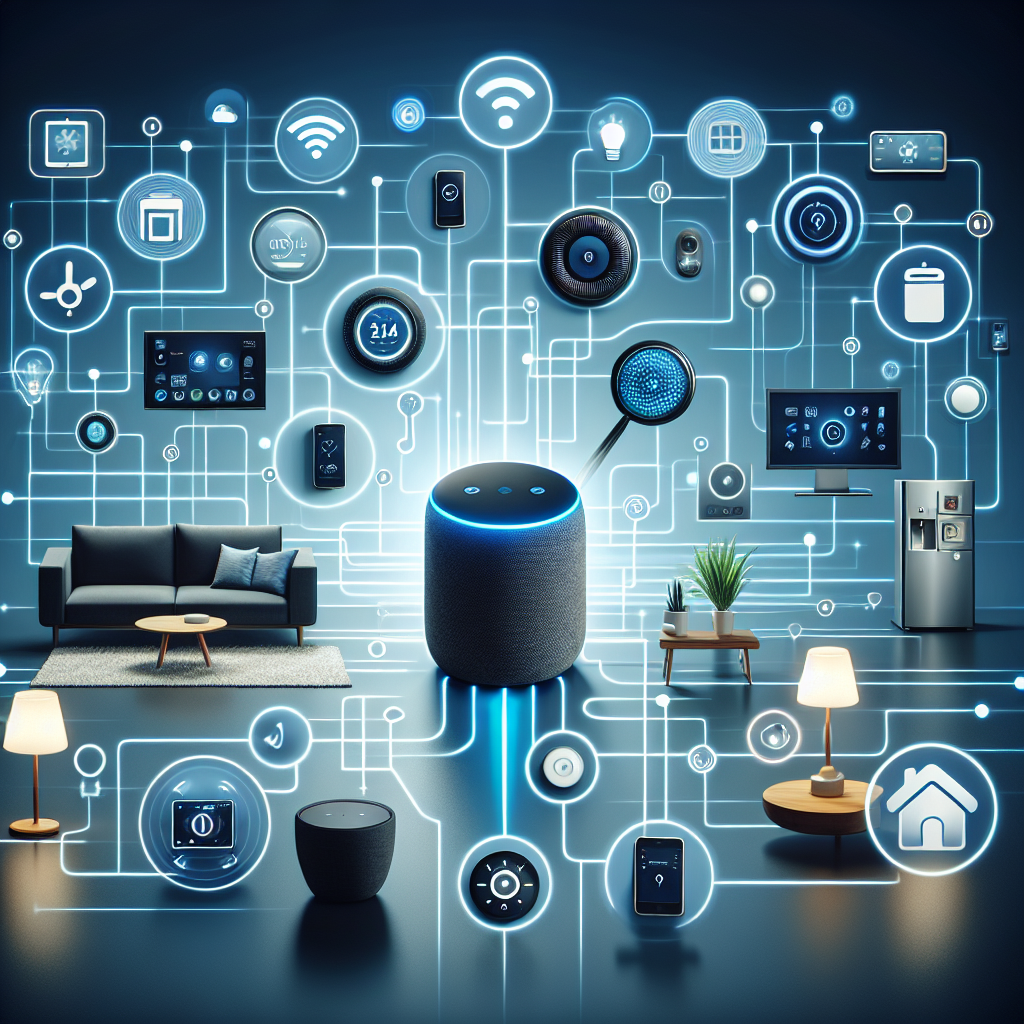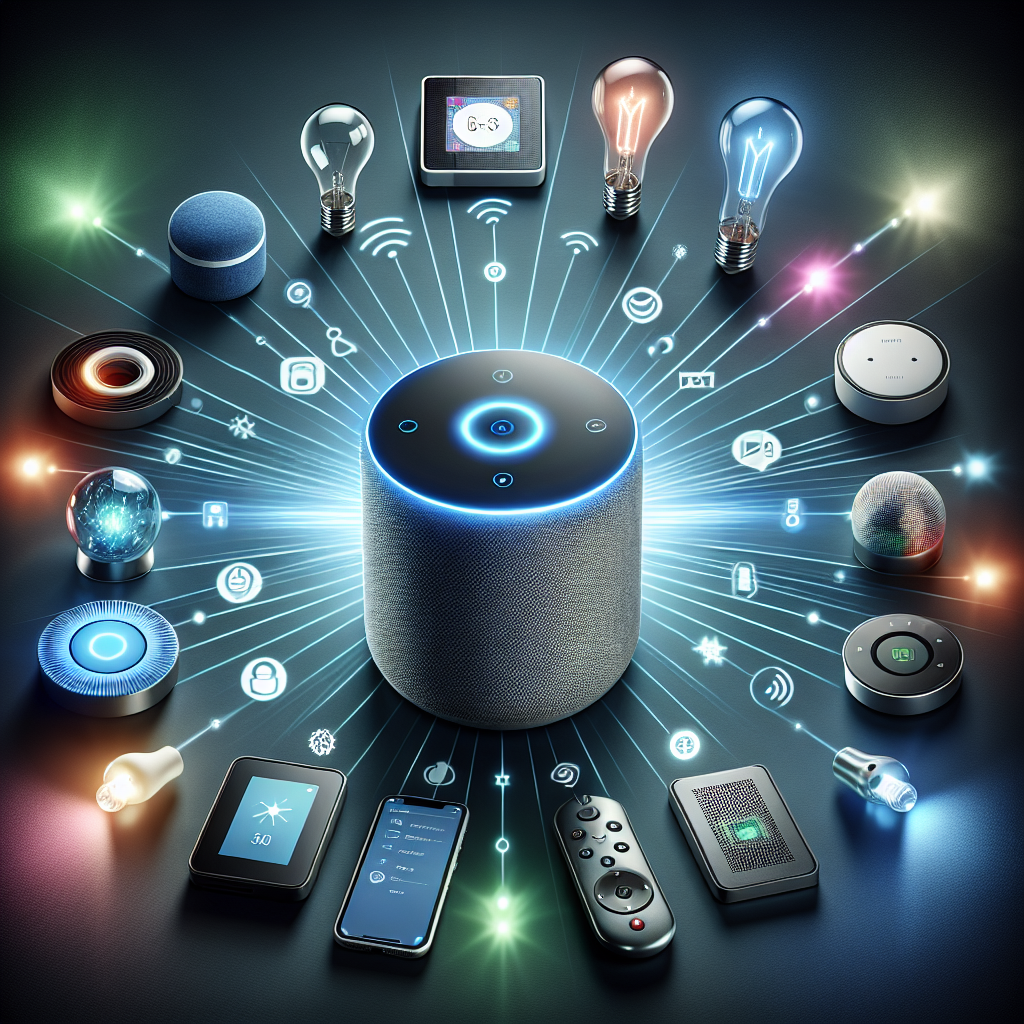Imagine having the power to control all the smart devices in your home with just the sound of your voice. With the rise of smart speakers, this futuristic dream has become a reality for many. In this article, we will explore how you can utilize the capabilities of smart speakers to easily control various devices in your home, making your everyday life more convenient and efficient. From turning on the lights to adjusting the temperature, you’ll learn the ins and outs of utilizing this cutting-edge technology to create a truly smart home experience. So, get ready to revolutionize the way you interact with your devices, as we show you how to harness the power of smart speakers in your own home.

Understanding Smart Speakers
What are smart speakers?
Smart speakers are innovative devices that combine voice recognition technology with wireless connectivity to provide a hands-free and convenient way to control various smart devices in your home. These devices are typically equipped with virtual assistants, such as Amazon Alexa or Google Assistant, which respond to voice commands and perform tasks on your behalf. Whether you want to adjust the lighting, play music, or even order groceries, smart speakers are designed to make your life easier and more connected.
How do smart speakers work?
Smart speakers use a combination of built-in microphones, powerful processors, and cloud-based algorithms to interpret and respond to your voice commands. When you speak a wake word or phrase, such as “Hey Alexa” or “Ok Google,” the smart speaker’s microphones pick up the audio, which is then converted into a digital format. This digital audio is sent to the cloud, where it is analyzed and matched with the appropriate command. The smart speaker then executes the command by sending instructions to the connected smart devices, allowing them to perform the desired actions.
Compatible Smart Devices
Different types of smart devices
There is a wide variety of smart devices that can be controlled using smart speakers. These include:
- Smart lights: LED bulbs and light strips that can be dimmed, change colors, or even be controlled remotely.
- Smart plugs and outlets: Allows you to turn regular appliances on or off using voice commands or through a smartphone app.
- Smart thermostats: Allows you to control the temperature and settings of your heating and cooling systems remotely.
- Smart security systems: Includes various devices such as smart door locks, cameras, and motion detectors that can be monitored and controlled using a smart speaker.
- Smart TVs and streaming devices: Allows you to control your TV and streaming services using voice commands.
- Smart speakers and soundbars: Control the playback and volume of music or other audio content in different rooms of your house.
Brands that offer smart devices compatible with smart speakers
Many popular brands offer smart devices that are compatible with smart speakers. Some of the most well-known brands include:
- Philips Hue: Offers a wide range of smart lighting products that can be controlled through smart speakers like Amazon Echo or Google Home.
- TP-Link: Offers smart plugs and switches that can be controlled using voice commands through compatible smart speakers.
- Nest: Known for its smart thermostats and cameras, Nest devices can be integrated into your smart speaker ecosystem.
- Samsung SmartThings: Provides a wide range of smart devices, including sensors, smart door locks, and security cameras that can be controlled through smart speakers.
- Sonos: Offers a range of smart speakers and soundbars that can be controlled using voice commands with smart speakers like Amazon Echo or Google Home.

Setting up your Smart Speakers and Smart Devices
Choosing the right location for your smart speaker
To ensure optimal performance, it is important to choose the right location for your smart speaker. Ideally, it should be placed in a central location within your home where it can easily pick up your voice commands. Avoid placing it near obstructions or in areas with excessive background noise. Additionally, make sure to keep it away from sources of heat or moisture, such as radiators or bathrooms, as this can damage the device.
Connecting your smart speaker to your Wi-Fi network
To connect your smart speaker to your Wi-Fi network, you’ll need to follow the manufacturer’s instructions. Typically, this involves using a smartphone app provided by the smart speaker brand to connect to your Wi-Fi network. Once connected, the smart speaker will have access to the internet, allowing it to interact with various online services and control your smart devices.
Connecting and activating your smart devices
To connect and activate your smart devices with your smart speaker, you’ll need to go through a similar process for each device. This usually involves installing the manufacturer’s app, connecting the device to your Wi-Fi network, and then linking it to your smart speaker through the app. Once connected, you can use voice commands to control the device through your smart speaker. Make sure to follow the specific instructions provided by the device manufacturer for the best results.
Voice Control Basics
Using wake words or phrases
The primary way to interact with your smart speaker is by using wake words or phrases. These wake words or phrases, such as “Hey Alexa,” “Ok Google,” or “Hey Siri,” prompt the smart speaker to listen for and respond to your commands. When you say the wake word, the smart speaker’s microphones activate, and you can then proceed to give your command or ask a question. It’s important to familiarize yourself with the specific wake word for your smart speaker and use it at the beginning of each command for optimal performance.
Adjusting the volume and playback
Controlling the volume and playback of audio content is easy with a smart speaker. You can simply say commands like “Turn up the volume,” “Play,” “Pause,” or “Skip to the next track.” Additionally, some smart speakers have touch controls or buttons on the device itself that allow you to manually adjust the volume or control playback. Experiment with different voice commands and familiarize yourself with the specific features and controls of your smart speaker to make the most of its capabilities.

Controlling Lights and Appliances
Switching lights on and off
Controlling your smart lights using a smart speaker is a breeze. You can say commands like “Turn on the living room lights” or “Turn off the bedroom lights” to control the lights in different rooms. Additionally, you can use more specific commands like “Dim the lights to 50 percent” or “Change the lights to blue” to customize the ambiance according to your preferences. With the help of a compatible smart speaker, you no longer need to manually switch lights on and off or fumble for light switches in the dark.
Adjusting brightness
If you want to adjust the brightness of your smart lights, you can simply say commands like “Brighten the lights” or “Dim the lights.” Smart speakers are designed to control the brightness level of compatible smart lights, allowing you to create a cozy atmosphere for movie nights or a brighter environment for reading or working. Remember to check if your specific smart lights are compatible with dimming functions and adjust the brightness to your desired level using voice commands.
Controlling smart plugs and outlets
Using a smart speaker, you can control regular appliances that are connected to smart plugs or outlets. With a voice command like “Turn on the coffee maker” or “Turn off the fan,” you can easily control these devices using your smart speaker. It’s important to ensure that the appliances you want to control are connected to compatible smart plugs that can be linked to your smart speaker. This way, you can conveniently control and automate various appliances without the need to physically interact with them.
Thermostats and Climate Control
Adjusting the temperature in your home
smart thermostats offer convenient control over your home’s heating and cooling systems. Using a smart speaker, you can adjust the temperature with simple voice commands like “Set the temperature to 75 degrees” or “Increase the temperature by 2 degrees.” You can also ask about the current temperature or set schedules for different temperature settings throughout the day. With the ability to control your thermostat through a compatible smart speaker, you can ensure comfort and energy efficiency without leaving your seat.
Creating custom temperature schedules
Smart speakers can also help you create custom temperature schedules for different times of the day. By saying commands like “Set the thermostat to eco mode at 10 pm” or “Raise the temperature in the morning,” you can automate the temperature settings in your home based on your preferences and daily routines. This feature allows you to optimize energy usage and ensures that your home is always at the desired temperature without constant monitoring or manual adjustments.

Home Security
Arming and disarming your smart security system
If you have a smart security system installed in your home, you can control it using your smart speaker. By saying commands like “Arm the security system” or “Disarm the alarm,” you can conveniently control the security settings without the need for a separate keypad or mobile app. This feature provides you with peace of mind and ensures that your home is secure even when you are away. Make sure to follow any additional security measures recommended by the manufacturer to protect your home and privacy.
Receiving alerts and notifications
Smart speakers can also be set up to provide alerts and notifications about your home’s security status. Whether it’s motion detected by security cameras, a door or window being opened, or a smoke detector going off, your smart speaker can notify you using voice prompts or by flashing its lights. This real-time information keeps you informed and allows you to take immediate action if necessary. Ensure that you have properly configured your smart devices and notifications settings to receive alerts that are relevant to your specific security needs.
Multimedia Devices
Playing music and podcasts
One of the most popular uses of smart speakers is their ability to play music and podcasts. With a simple voice command like “Play some music” or “Play the latest episode of my favorite podcast,” you can enjoy your favorite content without needing to manually search for it on your phone or computer. Smart speakers can connect to various music streaming services, such as Spotify, Apple Music, or Amazon Music, allowing you to access a vast library of songs and podcasts with ease.
Controlling TVs and streaming devices
Smart speakers can also act as a hub for controlling your TV and streaming devices. Simply say commands like “Turn on the TV” or “Play ‘Stranger Things’ on Netflix” to control your entertainment system. Some smart speakers even come with built-in infrared blasters that allow them to send signals to the TV or other devices, enabling seamless control without the need for additional remotes. Check if your smart speaker supports compatibility with your specific TV or streaming device for optimal control.
Controlling speakers and soundbars
If you have speakers or a soundbar connected to your smart speaker, you can control their playback and volume using voice commands. Whether you want to adjust the volume, skip to the next track, or switch inputs, you can do so easily by saying the appropriate command. This feature adds convenience and flexibility to your audio setup, allowing you to enjoy your favorite music or enhance your TV viewing experience without the need to physically interact with the speakers or soundbar.

Smart Home Routines and Automation
Creating custom routines
One of the most powerful features of smart speakers is the ability to create custom routines. With routines, you can automate a series of actions using a single voice command. For example, you can create a routine called “Good Morning” that turns on the lights, adjusts the thermostat, and plays your favorite news podcast. By speaking the command “Good Morning” to your smart speaker, it will execute all the actions simultaneously. Custom routines allow you to personalize and streamline your daily routines, providing convenience and efficiency throughout your day.
Automating tasks based on time and events
Smart speakers also offer the ability to automate tasks based on specific time or events. For example, you can set up an automation that turns on the lights and plays relaxing music when you arrive home after work or when motion is detected in a specific area. By using voice commands or through the smart speaker’s app, you can configure these automations to suit your preferences and make your smart home work for you. Experiment with different automation options to find the ones that enhance your lifestyle and make your home more efficient.
Advanced Features and Integrations
Voice shopping and ordering
Some smart speakers allow you to shop and order products using just your voice. With integrated virtual assistants like Amazon Alexa, you can add items to your shopping list, reorder products, or even make purchases from participating retailers. This feature makes it easy to restock everyday items or explore new products without needing to open a shopping app or use a computer. Keep in mind that additional setup or account linking may be required to enable this feature.
Integrating with virtual assistants
Smart speakers can integrate with virtual assistants to provide a more comprehensive and personalized experience. By linking your smart speaker with your virtual assistant account, you can access your calendar, check the weather, set reminders, or even ask for general knowledge questions. Virtual assistants like Siri, Google Assistant, or Cortana can enhance the capabilities of your smart speaker, giving you access to a wealth of information and services. Follow the instructions provided by your smart speaker manufacturer to set up the desired virtual assistant integration.
Controlling multiple rooms or zones
If you have multiple smart speakers placed in different rooms or zones of your home, you can control them individually or as a group. By saying commands like “Play music in the living room” or “Turn off all the lights,” you can control specific devices or execute actions in multiple locations simultaneously. This feature allows you to create a whole-home audio experience or manage different areas of your home with ease. Familiarize yourself with the specific voice commands supported by your smart speaker to make the most of its multi-room capabilities.
In conclusion, smart speakers provide a convenient and efficient way to control various smart devices in your home using voice commands. From controlling lights and appliances to managing your home security and multimedia devices, smart speakers offer a wide range of features and integrations that enhance your smart home experience. By following the setup instructions, exploring the voice control basics, and utilizing the advanced features, you can harness the power of smart speakers to create a seamless and connected home environment. So go ahead, embrace the benefits of smart technology and let your voice be the driver of your smart home.










